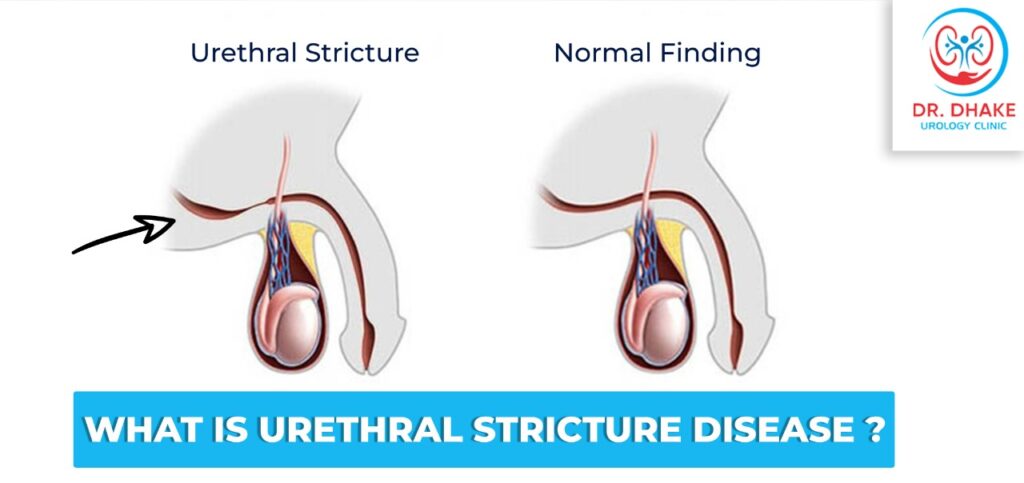
The urethra’s main job in males and females is to pass urine outside the body. This thin tube also has an important role in ejaculation for men. When a scar from swelling, injury or infection blocks or slows the flow of urine in this tube, it is called a urethral stricture. Some people feel pain with a urethral stricture.
What Happens under Normal Conditions?
The bladder empties through the urethra and out of the body (called voiding). The female urethra is much shorter than the males. In males, urine must travel a longer distance from the bladder through the penis.
In males, the first 1″ to 2″ of the urethra that urine passes through is called the posterior urethra. The posterior urethra includes:
- the bladder neck (the opening of the bladder)
- the prostatic urethra (the part of the urethra by the prostate)
- the membranous urethra
- a muscle called the external urinary sphincter
Strictures that happen in the first 1″ to 2″ of the urethra that urine passes through are called posterior strictures.
In males, the final 9″ to 10″ of the urethra is called the anterior urethra. The anterior urethra includes:
- the bulbar urethra (under the scrotum and perineum- the area between the scrotum and anus)
- the penile urethra (along the bottom of the penis)
- the meatus (the exit at the tip of the penis)
Strictures that happen in the last 9″ to 10″ of the urethra that urine passes through are called anterior strictures.
Causes
Men are more likely to have a urethral disease or injury because of their longer urethra. For this reason, strictures are more common in men. They are rare in women and in infants.
Stricture (narrowing of the urethra) can happen at any point from the bladder to the tip of the penis. This narrowing restricts or slows the flow of urine in. Some common causes are:
- trauma to the urethra
- infection such as a sexually transmitted disease
- damage from surgical tools
- conditions that cause swelling
In most cases, no cause can be found.
In adults, urethral strictures are most often due to:
- injury from a fall onto the scrotum or perineum
- prostate surgery
- kidney stone removal
- urinary catheterization
- other surgical tools
Posterior Urethral Stricture
Posterior urethral strictures happen in the first 1″ to 2″ of the urethra. This kind of stricture is due to an injury linked to a pelvic fracture (e.g., motor vehicle or industrial accident). In these cases the urethra is disrupted, or completely cut and separated. Urine cannot pass. A catheter must be placed either through the abdomen into the bladder (suprapubic tube), or through the penis into the bladder. This lets urine drain until the stricture can be fixed.
Anterior Urethral Stricture
Anterior urethral strictures happen in last 9″ to 10″ of the urethra. This kind of stricture is caused by:
- trauma from a straddle injury (from falls onto objects where the legs are on either side)
- direct trauma to the penis
- catheterization
Symptoms
Simply put, the urethra is like a garden hose. When there is a kink or narrowing along the hose, no matter how short or long, the flow is reduced. When a stricture is narrow enough to decrease urine flow, you will have symptoms. Problems with urinating, UTIs, and swelling or infections of the prostate may occur. Severe blockage that lasts a long time can damage the kidneys.
Some signs are:
- bloody or dark urine
- blood in semen
- slow or decreased urine stream
- urine stream spraying
- pain with urinating
- abdominal pain
- urethral leaking
- UTIs in men
- swelling of the penis
- loss of bladder control
Diagnosis
There are several tests to determine if you have a urethral stricture including:
- physical exam
- urethral imaging (X-rays or ultrasound)
- urethroscopy (to see the inside of the urethra)
- retrograde urethrogram
Urethroscopy
The doctor gently places a small, bendable, lubricated scope ( a small viewing instrument) into the urethra. It is moved up to the stricture. This lets the doctor see the narrowed area. This is done in the office and helps your doctor decide how to treat the stricture.
Retrograde Urethrogram
This test is used to see how many strictures there are, and their position, length and severity. This is done as an outpatient X-ray procedure. Retrograde in this case means “against the flow” of urine. Contrast dye (fluid that can be seen on an X-ray) is inserted into the urethra at the tip of the penis. No needles or catheters are used. The dye lets the doctor see the entire urethra and outlines the narrowed area. It can be combined with an antegrade urethrogram (antegrade means “with the flow” of urine). Dye inserted from below fills the urethra up to the injured area. Dye inserted from above fills the bladder and the urethra down to the stricture. These tests together let the doctor find the gap to plan for surgery.
Also, if you have trauma to the urethra, you may have this X-ray procedure after emergency treatment. Contrast dye can be injected through the catheter that was placed for healing.
Prevention
- Avoid injury to the urethra and pelvis.
- Be careful with self-catheterization
- Use lubricating jelly liberally
- Use the smallest possible catheter needed for the shortest time
- Avoid sexually transmitted infections.
- Gonorrhoea was once the most common cause of strictures.
- Antibiotics have helped to prevent this.
- Chlamydia is now the more common cause.
- Infection can be prevented with condom use, or by avoiding sex with infected partners.
- If a problem occurs, take the right antibiotics early. Urethral strictures are not contagious, but sexually transmitted infections are.
Treatment
There are many options depending on the size of the blockage and how much scar tissue is involved.
Treatments include:
- dilation – enlarging the stricture with gradual stretching
- urethrotomy – cutting the stricture with a laser or knife through a scope
- open surgery – surgical removal of the stricture with reconnection and reconstruction, possibly with grafts (urethroplasty)
There are no available drugs to help treat strictures.
Without treatment, you will continue to have problems with voiding. Urinary and/or testicular infections and stones could develop. Also, there is a risk of urinary retention (when you can’t pass urine), which could lead to an enlarged bladder and kidney problems.
Dilation
This is usually performed in the urologist’s office with local anaesthesia. The stricture is stretched using larger and larger dilators called “sounds.” A special balloon on a catheter can also stretch the tissue. But this stretching is not really a cure and needs to be repeated regularly. If the stricture comes back too quickly, you may be taught how to insert a catheter from time to time to prevent it from coming back. Side effects include bleeding and infection. Sometimes a “false passage” or second urethral channel may form from the stretching.
Urethrotomy
This uses a special scope that is moved along the urethra until the stricture is found.
A knife blade or laser at the end of the cystoscope is used to cut the stricture and create a gap. A catheter may be placed into the urethra to hold the gap open and let it heal. The suggested time to leave a catheter tube draining is based on the length of the stricture.
Open Surgery
Many reconstructive procedures have been used to treat strictures, and some involve 1 or 2 operations. In all cases, the choice of repair is based on the location and length of the stricture and how serious it is. No single repair is right for all cases. The 2 main types are anastomotic urethroplasty and substitution urethroplasty.
Anastomotic Urethroplasty
This method is usually reserved for short urethral strictures. In this case, a cut is made between the scrotum and rectum. The urethra can then be reconnected after removing the stricture. This is usually performed as an outpatient procedure or with a short hospital stay. A small, soft catheter is left in the penis for 10 to 21 days. It is then removed after an X-ray is taken to make sure the repair has healed.
Substitution Urethroplasty
When the stricture is long, tissue can be transferred to replace the section that had the stricture. In difficult cases, substitution repairs may need to be done in stages. These repairs should be done by a urologist experienced with these surgeries. Overall the success rates are very good. The 3 kinds of substitution procedures are:
- Free graft
- Skin flap
- Staged
Free Graft
This method replaces or enlarges a section of the urethra using your own tissue. The tissue may be skin (taken from the shaft of the penis) or, more often, buccal mucosa (taken from inside the cheek). After surgery, you may need a short hospital stay and use a catheter for 2 or 3 weeks.
Skin Flap
With this surgery, flaps of skin are rotated from the penis to create the new section of the urethra. This is needed when a graft needs to be long, and the stricture is severe. These procedures are complex and should be done by a surgeon with plastic surgery experience. After surgery, you may need a short hospital stay and use a catheter for 2 or 3 weeks.
Staged
This method is used when local tissue will not work for a free graft or a skin flap.
- First stage – The underside of the urethra is opened, which shows the full length of the stricture. A graft is secured to the opened urethra. The graft heals and matures for 3 months to a year. During that time, you will urinate through a new opening behind the stricture. This may mean that you have to sit down to urinate while the graft heals.
- Second stage – Several months after the graft around the urethra has healed, and it is soft and flexible, the graft is formed into a tube. The urethra then returns to normal. A small, soft catheter is left in the penis for 10 to 21 days.
After Treatment
Because urethral strictures can come back after surgery, you should be followed by a urologist. After the catheter is removed, your doctor will want to check you with physical exams and X-rays as needed. Sometimes the doctor performs urethroscopy to check the repair. In some patients, the stricture may return but may not need additional treatment. But if it causes obstruction, it can be treated with urethrotomy or dilation. Repeat open surgery may be needed for serious strictures that come back.
Questions to Ask Your Doctor
- What symptoms should I tell you or your office about?
- What are the pros and cons of each treatment option?
- Is there anything I can do to prevent the stricture from coming back?
- What problems could occur during or after surgery?
- How long will follow-up care be needed?




